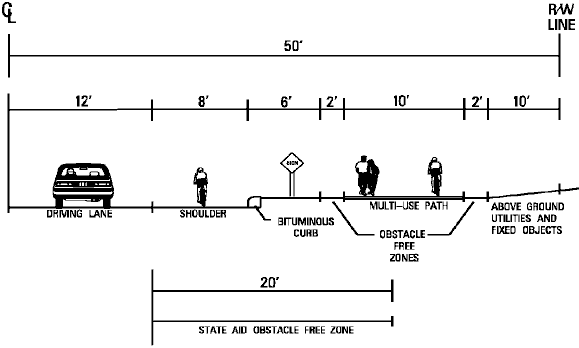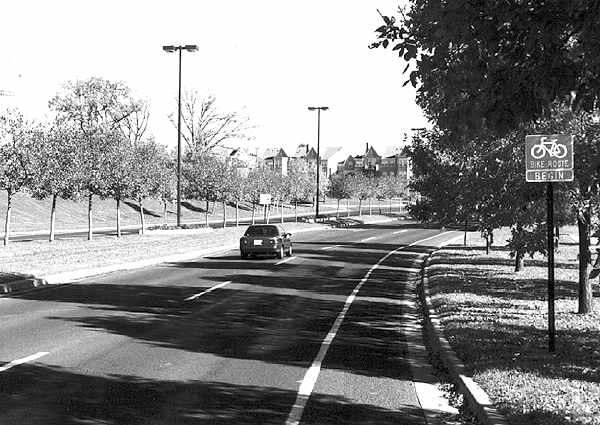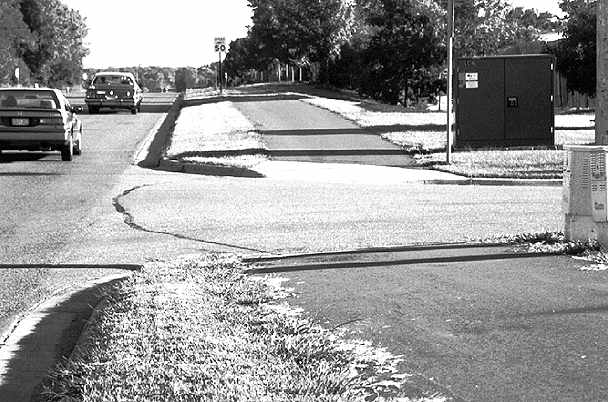JOHN S. ALLEN'S BICYCLE FACILITIES, LAWS AND PROGRAMS PAGES |
||
 |
Top: Home Page Up: Minneapolis Previous: evaluation Next: Alec Kloss's comments |
 |
JOHN S. ALLEN'S BICYCLE FACILITIES, LAWS AND PROGRAMS PAGES |
||
 |
Top: Home Page Up: Minneapolis Previous: evaluation Next: Alec Kloss's comments |
 |
Review of the
|
"Full accommodation" -- two-way sidepath
plus street with bike lanes.

"Full accommodation" (page 6) is defined as a roadway with bicycle lanes, plus a sidepath. The photo illustrating this arrangement, which is described as "ideal" (top level, that is, despite the disclaimer about levels), shows a lightly traveled road with bike lanes, and a sidepath adjacent to a stone wall -- clearly a two-way sidepath, as there in none on the other side. "Wrong-way" travel on a sidepath is highly hazardous, because drivers crossing the sidepath are looking in the opposite direction for traffic. I have sharpened the photo from the Plan, revealing that the cyclist -- the only cyclist who appears in any of the photos illustrating the five types of accommodation -- has been added using photo editing. It's no wonder that the cyclist had to be faked -- a cyclist of the sort who wears special cycling clothes would be unlikely to ride on a sidepath which he or she would know to be highly hazardous at normal bicycle travel speeds. In the background (see arrow), is a driveway or cross street where the approach of a cyclist would be concealed by the stone wall and by vegetation, increasing the hazard. With the wall adjacent to the sidepath, the example given in the photo does not even conform to the cross-section diagram which is included in the Executive summary. (This is one of many geometric diagrams in the Executive Summary online. The others describe the other "levels".). |

The quandary of "full accommodation" is that a sidepath attracts novice cyclists without assuring their safety. The roadway accommodation shown in the pictures, without the sidepath, would be entirely appropriate to any child a parent would allow out of sight on a bicycle. |
"Independent trail"

"Independent trail" (page 7) is described as the usual multi-use trail on an abandoned rail right-of-way or other right-of-way where there is not a road. The Plan states:
Trails are popular, and can not be judged only on their merits for bicycling, as they serve other constituencies besides cyclists. The quoted statement acknowledges that trails are not safe for travel at full bicycle speed when crowded with other users. However, the report does state that "the independent trails form a part of the primary bicycle system due to their incorporation of limited vehicle crossings and grade separations." This is a problematic statement because it implies that other routes might be disregarded if a trail is constructed. An alternate, parallel route might be needed when
Also note in the photo above that the trail is unpaved, raising issues of the durability of the surface and making pavement markings impossible; there are wide tire marks on the trail, suggesting that it is serving motor vehicles; and the far side of the crossing is concealed from motor traffic by vegetation. This trail might be useful for bicycling but it is by no means an optimum example. |
"Bicycle compatible roadway"

"Bicycle compatible roadways" (page 9) are described as
The statement is implicitly made here that a roadway must be designated in order to be suitable for bicycle use, when in fact, bicycles are permitted on all but limited-access roadways, and there are many roadways, especially in residential and rural areas, which serve even novice and child cyclists well just as they are. There is no discussion whatever of the design issues and problems which can occur with special bicycle facilities on the roadway. The example from the Plan, shown in the photo above, is a very nearly ideal one; a parkway with no cross traffic. Still, it appears that the area to the right of the solid stripe is not a bike lane, as there are no bike lane symbols or markings. It is then possible that this area would be used lawfully for parking during times of heavy use of the park through which it passes. In that case, the roadway would still be suitable for use by competent cyclists, but it would not attract children or novices. "Multi-use paths" are described as
|
"Multi-use path" -- actually a sidepath.

| Aside from the distressingly poor design elements, just what is intended by the
statement that sidepaths are "on a par with the bicycle-compatible roadways"?
This statement is meaningless, because the two types of facility are so different. The words "multi-use path" are generally used to describe what this report calls an "independent trail." What the photo shows is in fact a two-way sidepath. It has obstacles -- signposts and an electrical junction box -- too close to its edge to meet standard engineering guidelines. Also, there is a large sight obstruction for drivers who are about to cross the path to enter the roadway. These elements do not conform to the geometric diagram in the Executive Summary. The roadway in the photo appears to have ample width for bicycle/motor vehicle lane sharing. The speed limit of 50 mph, typical of rural areas, does correspond to a higher likelihood of overtaking collisions than occurs with lower speed limits, though such a high speed limit is unusual for a roadway with curbs and driveway entrances. The temptation to construct sidepaths is strong, because they can also serve as sidewalks, and because many people believe that cycling on sidewalks is safe. But these people are wrong. Being adjacent to roadways, sidepaths do not provide a quiet, scenic recreational experience. They reach more trip generators than typical trails, but they are just as unsuitable for winter use by cyclists, and for use by fast cyclists when crowded. But sidepaths -- unless they can be placed far from the roadway and are not crossed by driveways or streets -- have serious hazards that "independent trails" do not have:
Sidepaths are the preferred choice only in a few special circumstances. Widening the road (but adding a narrower sidewalk for pedestrians) and possibly lowering the speed limit, or a trail away from the roadway, all would be preferable in the situation shown. Sidepaths are also seen by cycling advocates as a threat to their right to ride on the roads. Minnesota does not have a mandatory sidepath rule, but harassment of cyclists for riding on the roadway is common where sidepaths exist. |
"Basic accommodation"

"Basic Roadway accommodations" are described as follows:
This is an extraordinary statement, because in fact, the great majority of roadways in the project area would have no special provision for cyclists, even if the entire plan is completed. Furthermore, the clear indication that a wide outside lane is an undesirable accommodation for cyclists (and that the roadway is not "bicycle-compatible") is without any basis in scientific fact, and runs counter to the experience of cyclists over several decades. And once again, a "level" statement is made, despite the earlier disclaimer. The photo illustrating "basic roadway accommodations", unlike any of the others, shows a location which is poorly maintained and esthetically unattractive. It is on an arterial street -- though in fact, the great majority of the street mileage which is not designated as a bicycle route is on local and collector streets that carry only light traffic. The photo also shows a road defect that could just as easily occur anywhere else: a wide gutter pan with an uneven seam such that cyclists would have to ride well to its left or else risk a diversion-type fall. If this problem were remedied, the width of the outside lane would be more than ample for bicycle-motor vehicle lane sharing. ConclusionThis report fails to address three of the four major elements of a bicycle program, and is very troubling in the way it addresses the remaining one. Thanks to Sarah Etter for drawing my attention to this report. |
| Top: Home Page Up: Minneapolis Previous: evaluation Next: Alec Kloss's comments |
Contents © 2003, John S. Allen |